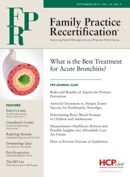Publication
Article
Family Practice Recertification
How Should I Handle This Patient Who Leaks Urine?
Author(s):
A 58 year old G2P2, married woman presents to your office for her annual well woman exam. Upon questioning, she tells you that for several months she's been having trouble with urinary leaking. "I just can't seem to get to the bathroom on time and I feel like I go more often than usual." She also has been urinating at least twice during the night. She denies urinary burning or dysuria
A 58 year old G2P2, married woman presents to your office for her annual well woman exam. Upon questioning, she tells you that for several months she’s been having trouble with urinary leaking. “I just can’t seem to get to the bathroom on time and I feel like I go more often than usual.” She also has been urinating at least twice during the night. She denies urinary burning or dysuria
What are the different types of urinary incontinence?
Urinary incontinence is defined as the complaint of any involuntary loss of urine. It can also be subcategorized into 3 distinct groups and one that combines several common symptoms. Stress urinary incontinence is a complaint of involuntary leakage with increased intra-abdominal pressure such as sneezing, coughing or jumping. There is also urge urinary incontinence, which is a complaint of involuntary leakage accompanied by, or immediately preceded by, urgency.
The third type is referred to as overflow incontinence, which is a complaint of involuntary leakage that is continuous. There is also mixed urinary incontinence, which usually describes both urge and stress incontinence in which the complaint of involuntary leakage is associated with urgency as well as with exertion, sneezing and coughing.
In this patient, the symptoms are consistent urge incontinence rather than overflow incontinence, as her leakage is not continuous.
What elements of the medical history are helpful in sorting out the causes of urinary incontinence?
Useful elements in the medical history include age, menopausal status, types of delivery (vaginal versus forceps versus Caesarean section), and other gynecological history (e.g. hysterectomy). Any symptoms of dysuria, pelvic pain, and hematuria are also helpful to distinguish other lower urinary tract problems.
It can also be useful to review any recent weight gain, medications the patient is taking as well as bowel habits which can all be helpful sources of clues as well.
Three incontinence questions (3 IQs) help distinguish urge from stress incontinence with a sensitivity of 75% and a specificity of 77%. These include 3 questions: (1) did you leak urine in the last three months? (2) Did you leak urine with activity, with urge, or with neither? (3) In what situation did leakage most occur.
In the third question, the clinician is able to categorize the symptoms into stress, urge, other, or mixed urinary incontinence.
What specific findings on physical examination are of particular value in the evaluation of urinary incontinence?
A general examination of the patient should be conducted with attention to mental status and mobility status as well as any evidence of volume overload with peripheral edema.
A neurologic evaluation involving the sacral nerves as well as any focal findings and/or evidence of peripheral neuropathy should also be performed. A pelvic examination is essential looking for evidence of vaginal atrophy that can be seen with loss of rugue and vaginal folds and friability of the vaginal epithelium.
A speculum examination looking for any evidence of urethral hypermobility, cystocele, uterine prolapse, rectocele or pelvic masses is also recommended, as is a rectal examination to assess active and resting sphincter tone, perineal sensation, as well as any evidence of fecal impaction or masses.
Finally, the post void residual (PVR) should be determined. This should be measured within 5 minutes of voiding by performing either bladder catheterization or bladder ultrasound.
What is the Q-tip test and how do you interpret the findings?
The Q-tip test is done at the time of pelvic examination by inserting a Q-tip into the urethra and asking patient to valsalva or bear down. Urethral hypermobility is present if the Q-tip angle changes by more than 90 degrees and supports the presence of bladder prolapse and/or stress incontinence.
Are there any diagnostic tests that should be considered?
Typical laboratory options for the evaluation of urinary incontinence include a serum glucose and calcium as elevations in both of these can cause polyuria. Other laboratory tests include a BUN and serum creatinine, especially if the post void residual is above 200cc, and urinalysis as well as a urine culture, if indicated. Urodynamic testing is not routinely recommended and is used mainly when surgery is being considered.
What is a "bladder diary" and how is it of value?
The bladder diary is a record over three days of the timing and volume, described in terms of “drops”, “small”, “medium”, and “soaking”, of continent and incontinent episodes.
The diary also tracks other activities including fluid intake, like coffee drinking, exercise, and hours of sleep. The diary provides a better understanding of the pattern of the patient’s incontinence as to whether it is nighttime only or day and night as well as the possible role of fluid intake and certain types of beverages that can be direct irritants to the bladder. The value of the diary is not only in helping make the diagnosis but also in measuring interval improvement if the patient is given a trial with medications and/or behavioral strategies.
The physical examination reveals a normal neurological examination, moderate vaginal atrophy, no pelvic organ prolapse and less than 30 degrees displacement during the Q tip test. The patient’s history suggests urge incontinence.
What are the treatment options for this patient?
Given that the patient has moderate vaginal atrophy, usually topical estrogen is recommended. In a woman who still has her uterus, low dose topical estrogen in the form of 1/4 applicator twice a week is recommended without additional progesterone. This therapy is usually continued for 8-12 weeks. Other options include limiting fluid after dinner to help with any nighttime urination.
The patient continues to experience symptoms despite a trial of topical estrogen, what would you recommend next?
Behavioral strategies would be my next line of treatment. These behavioral strategies would include bladder training, Kegel exercises, and pelvic muscle rehabilitation.
What instructions do you provide the patient regarding bladder training?
Bladder training is a behavioral therapy that is based on two general principles. Frequent voiding to keep the bladder volume low and training of the central nervous system and pelvic muscles to inhibit urgency.
The initial frequency of time voluntary voiding is based on the smallest time interval between voids and is usually obtained from a bladder diary or can be empirically started at every two hours. The voluntary time voiding is only done when the patient is awake.
Intervening urgency can be controlled using various relaxation techniques. The patient can sit down and concentrate on making the urgency decrease by taking deep breaths or walk to the bathroom. Once they feel like they can control the urgency, they can walk to the bathroom and void.
When the patient can go two days without leakage, the time between the scheduled voids is increased by 30-60 minutes and this process is continued until the patient is voiding every 3-4 hours without symptoms of urinary incontinence or frequent urgency. Successful bladder training takes several weeks.
It is important to remind the patient not to get discouraged as bladder training takes time and effort but is an effective way to get rid of incontinence without medications or surgery.
How do you instruct patients regarding Kegel exercises?
Pelvic muscle (Kegel) exercises are done to strengthen the urethral muscular closure mechanism and are also effective for urgency, stress, and mixed incontinence. They can also be used for pregnancy-related urinary incontinence. The basic pelvic muscle exercise regimen consists of three sets of 8-12 contractions sustained for 6-8 seconds each and performed 3-4 times a week and continued for at least 15-20 weeks.
Pelvic muscle exercises are most effective when the patient receives specific instructions and monitoring by their health provider. It is important to make sure the patient is using their pelvic floor muscles and not abdominal muscles to perform the exercise. The strength of the pelvic floor muscles can be assessed during the bimanual pelvic examination.
Pelvic muscle exercise training can be supplemented with the use of weighted vaginal cones in which a patient inserts in her vagina and uses muscle contraction to hold in place the weighted vaginal cone.
What is pelvic muscle rehabilitation?
Biofeedback can be a supplement to bladder training or pelvic muscle exercises. Biofeedback sessions may include vaginal or anorectal feedback to help patients identify and selectively contract pelvic muscles and respond to the sense of urgency. Biofeedback is a covered benefit by Medicare for patients who fail an initial 4 weeks of a behavioral therapy trial.
The patient reports continued symptoms despite doing her best to adhere to your recommendations.
What is the role of pharmacologic therapy?
If behavioral strategies fail, other therapies can be considered. The antispasmodic agents are the most frequently prescribed medications for urge incontinence as well as overactive bladder syndrome.
Medications in this family include oxybutynin (available in several formulations (immediate release, extended release, transdermal patch, and topical gel), tolterodine (immediate release and long acting), trospium, darifenacin, solifenacin and fesoterodine.
Usually there is not much difference between medications to treat urge incontinence. The efficacy in terms of reduced incontinent episodes with these agents is anywhere from 60-70% reduction in incontinence. Recently, mirabegron (Myrbetrig®), an alpha-3 adrenergic agonist was approved for the treatment of urge incontinence. This agent does not share the same side effect profile of the antispasmodic agents but can affect blood pressure since it is an adrenergic agonist.
What antispasmodic bladder medication do you generally start with?
Let me begin by repeating there are 6 antispasmodic agents available in different doses and formulations and that the efficacy of all these agents is thought to be similar. The choice and dose of the specific agent selected depends on several factors, including the patient’s underlying co-morbidities, possible drug- drug and drug-disease interactions, as well as adverse effects.
In my practice, I typically begin with oxybutynin at the lowest dose available and assess response to treatment after 4-6 weeks. If oxybutynin is not effective, tolterodine is my next choice. The quick onset of the immediate release preparations makes them more useful especially when continence is desired at specific times (e.g., nighttime symptoms). Patients may respond to one antispasmodic and not another. The extended release agents appear to have lower rates of adverse effects than the immediate release ones.
Discontinuation of these medications is high. This is due to their anticholinergic side effects, which include dry mouth, constipation, drowsiness, and decreased cognitive function. These agents should not be used in patients with gastric retention or angle closure glaucoma.
Under what circumstances would you refer a patient with urinary incontinence to a specialist?
I typically refer patient with a PVR greater than 200 cc, hematuria and the absence of infection, history of previous anti-incontinence surgery or radical pelvic surgery, 2 or more urinary tract infections within 12 months, symptomatic pelvic prolapse or pelvic pain, and failure to respond to an adequate therapeutic trial or uncertainty in the diagnosis.
About the Author

Family Practice Recertification
Dr. Eslami is a Clinical Professor of Medicine at the David Geffen School of Medicine at UCLA. All questions were posed byEditor-in-Chief Martin Quan, MD.





